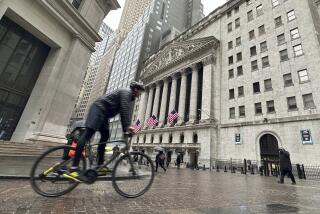Glitch shuts down trades on Nasdaq for 3 hours
NEW YORK — The Nasdaq Stock Market suffered a distressing three-hour outage that halted trading in some of the nation’s leading companies, the latest in a series of embarrassing glitches that have exposed technological weaknesses across Wall Street.
The snafu sent harried traders scrambling for alternative ways to conduct business and left legions of individual investors with no way to buy or sell shares of companies such as Apple Inc. and Google Inc.
The country’s second-largest stock market was disabled from 9:14 a.m. to 12:25 p.m. Pacific time. Nasdaq blamed a faulty data link that disseminates stock quotes among exchanges. It said the problem was corrected.
Trading resumed in the final 35 minutes of the day. Nasdaq ended up gaining 1.1%, though shares of its parent company, Nasdaq OMX Group Inc., slumped 3.4%.
Wall Street has long worked to project an image of technological sophistication, and rapid-fire computerized trading now dominates Wall Street.
But electronic breakdowns have become more common, and the lengthy time to correct the Nasdaq outage exposed what experts said was increasing digital complexity that has made the financial markets more fragile.
The shutdown recalled the marred initial public offering of Facebook Inc. last year and the May 2010 “flash crash” in which the Dow Jones industrial average sank nearly 1,000 points in minutes. Just this week, Goldman Sachs suffered a bout of botched options trading that forced the cancellation of thousands of orders.
“It’s just another black eye for Wall Street,” said Alan Valdes, a floor trader at the rival New York Stock Exchange. “It erodes confidence at a time when we don’t really need it. The market was getting a little footing here; you don’t need this.”
The big risk, experts said, is that a snafu could lead to significant losses for investors, especially if it struck on a busy day in a down market.
Aside from the challenge of pinpointing the cause of a problem, stock exchanges must walk back in time to reverse or repair millions of stranded stock orders. That’s a laborious process filled with guesswork that often leaves investors feeling shortchanged.
Luckily for Nasdaq, Thursday’s outage struck on a slow summer day when there was little economic news and much of Wall Street was on summer vacation. No estimate was available for possible losses.
“It could have been a disaster,” Valdes said. “They dodged a big bullet.”
Jim Angel, a finance professor at Georgetown University, said Nasdaq’s response makes it less likely that it will have to cancel thousands of trades or that the outage will result in securities lawsuits seeking hundreds of millions of dollars.
Still, the blackout prevented investors from reacting to what normally would have been market-moving news.
During the trading outage, billionaire investor Carl Icahn said via Twitter he has scheduled a dinner meeting with Apple’s chief executive, Tim Cook, to discuss a potential stock buyback — a development that might have otherwise stirred heavy trading.
“This is a very big deal,” said Sal Arnuk, co-founder of the brokerage Themis Trading in New Jersey, just before Nasdaq resumed trading Thursday. “We’re all very frustrated because we have orders we have to execute.”
Nasdaq’s outage initially stirred fears that Nasdaq was the victim of a cyberattack, following a series of hacker assaults against major banks and newspapers in the last year. The White House said President Obama had been briefed on the shutdown.
“There’s no reason, from what I know now, to believe that today’s incident has any of the more frightening aspects to it,” Treasury Secretary Jack Lew said at an event in California. “But we’re going to have to learn all the facts.”
Thursday marked the latest in a series of electronic mishaps at Nasdaq and elsewhere.
In May, Nasdaq was fined $10 million, the highest penalty ever paid by an exchange, for fumbling last year’s highly anticipated IPO of social networking giant Facebook Inc. The Securities and Exchange Commission later said Nasdaq’s system had a design flaw that failed to match buy and sell orders.
In March 2012, electronic exchange operator Bats Global Markets Inc. canceled its IPO because of a software bug in its own system. Bats, which stands for Better Alternative Trading System, had billed itself as a superior alternative to conventional stock exchanges.
Two years earlier, the harrowing flash crash saw the Dow plunged nearly 1,000 points before rebounding in the same afternoon.
Federal investigators later pinned the blame on high-frequency traders, who use supercharged computer programs to make big wagers on stocks. The SEC also singled out one investment firm, which had made a $4.1-billion trade using a computerized algorithm.
Some experts took the latest Nasdaq miscue in stride. “It’s the nature of all systems that they occasionally fail,” said Larry Harris, a USC professor and former SEC chief economist.
Nasdaq trading has twice been interrupted by squirrels. In 1987, a squirrel caused a power failure in Connecticut that shut down Nasdaq for about 90 minutes. In 1994, another squirrel nibbled through a power line at an electric company, causing a 30-minute shutdown.
Some traders said the SEC bore some responsibility for electronic breakdowns. It has allowed a crop of alternative trading venues to emerge, which they said has resulted in a sprawling and fragmented market.
“There’s a downside to having a thousand flowers bloom,” said Arnuk, who co-wrote “Broken Markets,” a book calling for Wall Street reform. “The market becomes complex and it becomes very, very hard to manage.”
Tangel reported from New York. Hamilton and Li reported from L.A. Jim Puzzanghera and Kathleen Hennessey in Washington contributed to this report.







